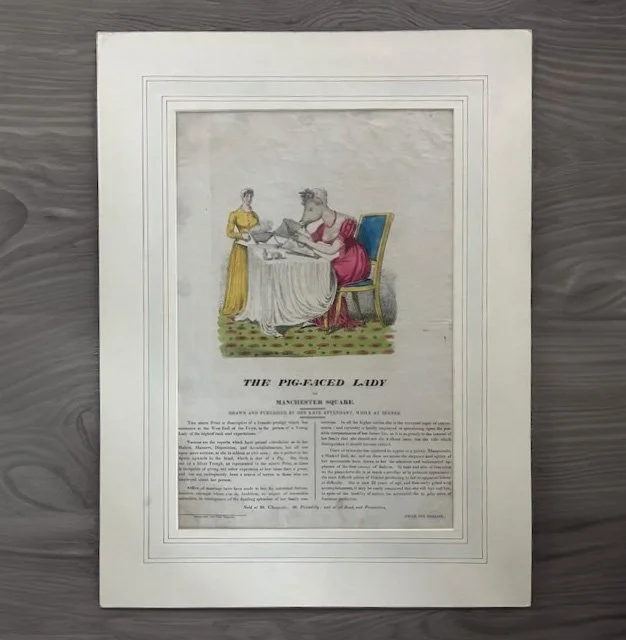As a household and community create accommodations for a woman with disabilities, she can participate more fully in the world around her
[Illustrated Broadside] [People with Disabilities]
The Pig-Faced Lady of Manchester Square. Drawn and published by her late attendant, while at dinner.
London: Jones and Co., [1814-1815]. First Edition. Hand colored etching with image and text to recto only. Measuring 400 x 270mm and mounted on board measuring 550 x 405mm. Near Fine condition, retaining its lovely pastel colors. Gentle creasing and small stains to verso barely visible on recto. One of two variants without clear priority (the other having fewer paragraphs and the imprint differently situated), the present version is unrecorded in OCLC and in Bodleian Ballads. The present is the only example to have appeared at auction (in 2021) and remains the only copy in trade.
While the legend of a pig-faced lady first emerged across England, the Netherlands, and France in the mid-seventeenth century, its early iterations differed significantly from the figure's later reemergence in the nineteenth century. Early depictions considered the lady's appearance as a result of a prodigious birth or witchcraft; and she served as a warning to pregnant women as well as a reminder of how much more easily wealthy families could hide away members they deemed "shameful." In 1814 and 1815, however, the lady made a return to popular culture; rumors spread through London about a newly arrived heiress in Marylebone whose body was fully human and whose head was porcine. Rather than hiding away entirely, the lady appeared publicly according to broadside reports as in the case of The Pig-Faced Lady of Manchester Square. And rather than feeling or being shamed about her appearance, the broadside suggests that she was able to teach her community not only to accept but even to accommodate her disabilities so she could maneuver more gracefully through society.
Depicting the Lady tastefully dressed and at an elegant table, the broadside also shows that she eats from a silver trough rather than being forced to conform to uncomfortable silverware and flatware use. The text notes that she was "in her Person of a Young Lady of the highest rank of society...once or twice she has ventured to appear at a private Masquerade, a Masked Ball, &c. and on these occasions the elegance and agility of her movements have drawn to her the attention and unbounded applauses of the first coteries of fashion. In taste and stile of execution on the piano-forte she is as much a prodigy as in personal appearance...it may easily be conceived that she will bye and bye, in spite of the hostility of nature, be accounted the ne plus ultra of feminine perfection." Thus, when provided spaces where her facial appearance blends in with the masks and costumes of others, her personality and talents take the fore and her community begin to truly value her. Indeed, she even becomes desirable within the marriage economy. "Offers of marriage have been made to her...and curiosity is hourly employed in speculating upon the possible circumstances of her future life." This is not to say that her life is depicted as perfect, nor her community's acceptance of her. Like so many people with disabilities, she confronts those who would take advantage of her, or who would pry into the deeply personal aspects of her life as if her body alone makes her a public figure and public property. "Fortune-hunters, amongst whom she is doubtless an object of irresistible attraction in consequence of the dazzling splendor of her family connections" are regular visitors to her home. And her neighbors think not only about whom she might marry, but they also debate about her reproductive viability. "It is so greatly to the interest of her family that she should not die without issue."
For all the imperfections existent in the mainstream community, The Pig-Faced Lady of Manchester Square suggests how different life can be when accommodations are available so that people with disabilities can more fully and independently maneuver through the world and participate in wider society.
Provenance: The Ricky Jay Collection (Lot 492). (47)

